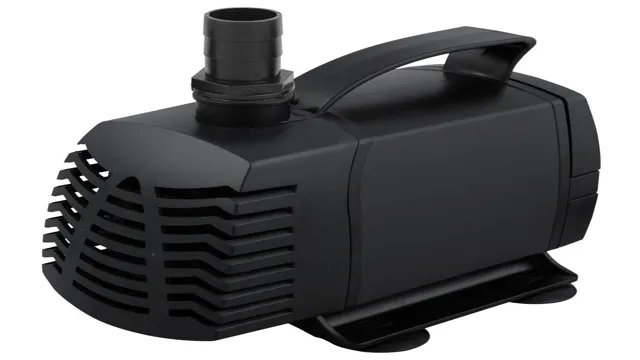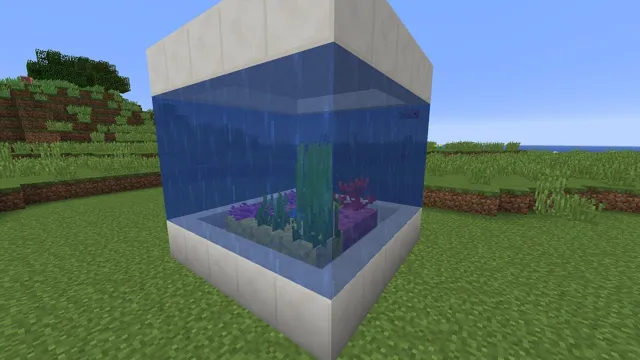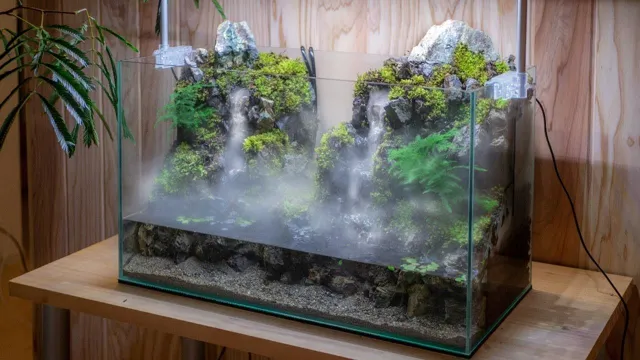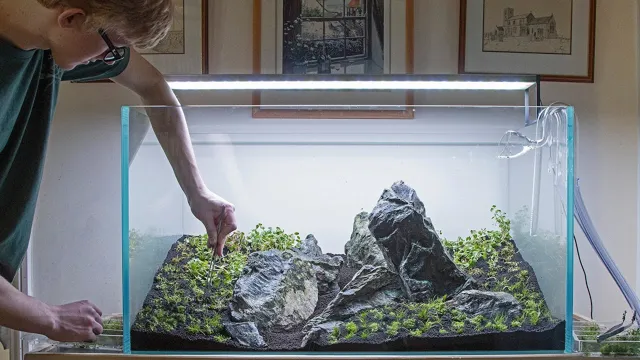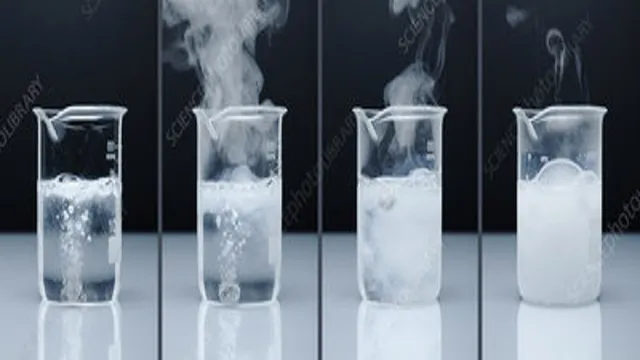How to Change Water in My Aquarium: A Step-by-Step Guide to a Cleaner Tank

As a proud owner of an aquarium, it’s essential to keep your fish and plants healthy by maintaining a clean environment. One crucial aspect of aquarium care is regularly changing out the water. Not only does it get rid of any build-up chemicals and waste products, but it also replenishes essential minerals and oxygen.
However, for beginners, the idea of changing out water in an aquarium can be daunting and complicated. But worry not, in this blog, we’ll walk you through the steps of how to change the water in your aquarium effortlessly, like a pro. So, sit tight and let’s dive in!
Preparation
Changing the water in your aquarium requires some preparation to ensure you don’t harm your fish or disrupt the balance of the environment in your tank. Before getting started, make sure you have all the necessary tools: a siphon hose, a bucket for the old water, and a water conditioner. Next, turn off any equipment running in your tank, such as filters or heaters.
Begin by siphoning water out of the tank, being careful not to disturb any decorations or plants. Start with removing around 10-15% of the water weekly or bi-weekly if necessary, depending on the size of your aquarium. As you siphon, use the hose to clean the gravel or sand in the tank, which will help to remove any debris.
Once you’ve removed the desired amount of water, you can add new water to the tank. Be sure to treat it first with water conditioner to remove any harmful chemicals that may be present. Add the water slowly and ensure the temperature is the same as the water in the tank to avoid shocking your fish.
Lastly, turn on any equipment that was turned off earlier, and keep a close eye on your fish for the next few hours to make sure they adjust well to the new water. Remember to repeat this process regularly to keep your aquarium healthy and your fish happy.
Gather necessary equipment
Preparation is key when it comes to gathering necessary equipment for any task, and this applies to virtually everything, including hobbies, sports, and an array of activities. When it comes to gathering equipment, understanding what you need and where to get it becomes essential. For instance, if you plan to take up fishing, you require a fishing rod, line, hooks, floats, reels, weights, tackle boxes, and bait, among other things.
It’s essential to source these materials from reputable stores or online shops to ensure that they are of good quality and durable. Additionally, it’s crucial to know how to assemble and use the equipment to get the most out of your activity. By gathering the necessary equipment, you can improve your chances of having a fulfilling experience and avoid disappointments.
Therefore, it’s vital to take preparation seriously and strive to get the best equipment within your budget.

Turn off all electric devices
Before you leave your house, make sure to turn off all electric devices to save energy and avoid any potential hazards. This means unplugging any appliances that aren’t in use, turning off lights, and switching off TVs and computers. Not only does this save you money on your energy bill, but it also reduces your carbon footprint and helps protect the environment.
Additionally, turning off all devices can prevent electrical fires and keep your home safe while you’re away. By taking a few extra moments to check that everything is turned off before leaving your home, you can ensure a safer, more energy-efficient environment for yourself and your family. So, be mindful of this simple and easy step to save energy and money while contributing positively to the environment.
Removing Old Water
Changing the water in your aquarium is important for maintaining a healthy environment for your fish. To remove the old water, you can use a siphon hose to vacuum up the water and any debris that has accumulated on the bottom of the tank. Start by unplugging any electrical equipment, such as heaters or filters, to prevent damage.
Then, place one end of the siphon hose into the tank and suck on the other end until water starts flowing through the hose and out into a bucket. Be sure to only remove about 25% of the water at a time to avoid shocking your fish. Once the water level has lowered to the desired amount, turn off the siphon and refill the tank with fresh, dechlorinated water.
Finally, plug in any equipment you previously unplugged and your aquarium will be clean and ready for your fish to thrive.
Unplug your filter and remove ornaments
When it comes to maintaining a clean and healthy aquarium, one of the essential things to do is to remove old water. It’s necessary to remove it to get rid of any debris, waste, and unwanted chemicals that might have accumulated over time. To do this, you should first unplug your filter and remove any ornaments or decorations in your aquarium that might obstruct the process.
Then, proceed to remove about 20-25% of the water in the tank. Use a siphon to suck out the water and clean the gravel at the same time. You can clean the suction tube using a small brush and some hot water.
Make sure to refill the tank slowly, using a dechlorinator to remove any chlorine from tap water. Remember, clean water is crucial for the health and well-being of your aquatic pets, so it’s recommended to do this at least once every two weeks.
Use a siphon to remove dirty water
If you have a fish tank or pond, you know that dirt and debris can accumulate quickly, leaving the water cloudy and unattractive. One way to address this issue is to use a siphon to remove old, dirty water. This method involves creating suction with a hose and letting gravity do the work of drawing the water out.
It’s important to note that you should never start a siphon with your mouth, as this can introduce harmful bacteria into the water. Instead, use a hand pump or other type of vacuum to create the necessary suction. Once the siphon is established, you can use it to remove as much water as you need, leaving behind clean, fresh water for your fish or plants.
This process can be repeated as often as necessary to maintain the health and beauty of your aquatic environment.
Take care not to remove all water
When removing stagnant water from your home or garden, it’s essential to be careful not to remove all the water entirely. Stagnant water is a breeding ground for mosquitoes and other insects, so it’s imperative to remove the water to prevent these pests from taking over. However, not all water should be removed as it’s an essential source of hydration for animals and plants.
For example, if you have a small pond in your garden, it’s crucial not to remove all the water as the fish and other aquatic creatures need it to survive. Hence, when removing old water, make sure to keep an appropriate amount of water available for flora and fauna to thrive. By doing so, you’re not only creating a healthy ecosystem around your home, but you’re also taking a small but meaningful step towards preserving nature.
Cleaning your Aquarium
If you’re wondering how to change the water in your aquarium, it’s actually a pretty straightforward process. The first step is to prepare your water. You should always use dechlorinated water.
Tap water has chlorine and other chemicals that are harmful to fish. One way to dechlorinate your water is to let it sit out for about 24 hours before using it. You can also use dechlorination products that you can purchase from a pet store.
Once you have prepared your water, it’s time to siphon out the old water. You’ll need a siphon hose to do this. Place one end of the hose in the tank and the other end in a bucket.
Start a siphon by sucking on the end of the hose until water starts to flow. Be sure to only remove about 25% of the water at a time. Once you have removed the old water, it’s time to add the new water.
Slowly pour the new water into the tank, being careful not to disturb the fish or the decorations. With these simple steps, you’ll be able to keep your aquarium clean and your fish healthy.
Clean the gravel and ornaments
When it comes to maintaining a clean and healthy aquarium, cleaning your gravel and ornaments is a crucial step. These elements can accumulate debris, waste, and harmful bacteria over time, which can harm your aquatic pets. To clean your gravel, you can use a siphon or a gravel vacuum to remove any dirt or waste that has settled to the bottom.
If you have live plants in your aquarium, be careful not to disturb their roots. For ornaments, you can use a soft-bristled brush or sponge to gently remove any algae or debris. Avoid using any harsh chemicals that can harm your fish or other creatures living in the tank.
Regular cleaning of the gravel and ornaments will not only benefit your pets, but it will also keep your tank looking fresh and beautiful. So, don’t forget this important step in maintaining a happy and healthy aquarium!
Wipe down the sides of the tank
Cleaning your aquarium is an important aspect of keeping your fish healthy. One task that often gets overlooked is wiping down the sides of the tank. It may seem like a small detail, but it can make a big difference in the overall cleanliness of your tank.
Over time, algae and other debris can build up on the sides of the tank, making it difficult to see your fish and giving off an unsightly appearance. To clean the sides of the tank, simply use a clean cloth or a scrubber designed specifically for aquarium use. Avoid using household cleaners or abrasive materials, as they can harm your fish.
By regularly wiping down the sides of your aquarium, you can ensure a clear view of your fish and create a healthier environment for them to thrive in.
Replacing with Fresh Water
Changing the water in your aquarium is an essential aspect of maintaining a healthy aquatic environment for your fish. The process may seem daunting at first, but it becomes relatively simple with practice. The first step is to determine how much water to remove.
The general rule of thumb is to replace 10-20% of the water every week. Before starting, ensure that you have all the necessary equipment, such as a siphon or a gravel cleaner, a bucket, and aquarium water conditioner. Begin by switching off all electrical equipment, such as heaters, and then start removing the old water using a siphon.
As you siphon, you can also use a gravel cleaner to vacuum up any debris from the substrate of the aquarium. Once you have removed the desired amount of water, fill the bucket with enough fresh, treated water to replace it and add the water conditioner as per the instructions. Finally, pour the fresh water slowly and carefully, to avoid disturbing the fish too much.
And there you have it, a simple way to replace the water in your aquarium and maintain a healthy aquatic environment.
Fill the tank with dechlorinated water
When it comes to caring for your aquarium, one of the most important things you can do is to regularly replace the water. This process involves filling the tank with dechlorinated water, which removes harmful chemicals that can be detrimental to your fish and plant life. Dechlorinated water is simply tap water that has been treated with a product that neutralizes any chlorine or chloramine that may be present.
It’s important to note that not all dechlorinators are created equal, so make sure to do your research and choose a high-quality product that will effectively remove harmful chemicals from your water. Once you’ve filled your tank with dechlorinated water, it’s a good idea to let it sit for a few hours to allow the water to reach room temperature and for any bubbles to settle. Regularly replacing your aquarium water is essential for maintaining the health and wellbeing of your aquatic pets, and ensuring that your tank remains a beautiful and vibrant addition to your home.
Condition the water before adding fish
One of the most important steps in setting up a new fish tank is conditioning the water before adding fish. This involves treating the water to remove any harmful chemicals and balance the pH levels for fish health. One way to condition the water is by completely replacing it with fresh, treated water.
This can be done by filling a clean bucket or container with fresh tap water and adding a water conditioner according to the instructions on the bottle. Then, slowly pour the treated water into the tank, taking care not to disturb any decorations or plants. Replacing the water is an effective way to ensure that the water is free of any contaminants and is safe for fish to thrive in.
Remember, taking the time to properly condition your aquarium water is crucial for the health and safety of your fish.
Conclusion
In conclusion, changing the water in your aquarium is like giving your fish a spa day. It’s essential for their health, happiness, and overall wellbeing. Not only does it remove harmful toxins and pollutants, but it also helps to maintain the chemical balance of the water.
Just remember to take it slow, use a siphon, and test the water before and after the change. With some patience and a little bit of elbow grease, your fish will be swimming in clear, clean water in no time. So go ahead and treat your fishy friends to a day at the spa – they’ll thank you for it!”
Frequent water changes maintain fish’s health
Frequent water changes are essential to maintaining your fish’s health. One of the best ways to achieve this is by replacing some of the aquarium water with fresh water. By doing so, you can lessen the concentration of dissolved waste and other harmful substances that accumulate over time.
A general rule of thumb is to replace about 10-15% of the water in your fish tank every week. This can be done by siphoning out the old water and slowly pouring in the fresh water. It’s important to ensure the temperature and pH levels of the fresh water match that of the existing tank to avoid any sudden changes that could harm your fish.
Regular water changes can help prevent disease, improve water clarity, and sustain a balanced and healthy environment for your fish. By establishing a routine of consistent water changes, you will not only help ensure the well-being of your fish, but you’ll also be able to enjoy a clear and clean aquarium.
FAQs
How often should I change the water in my aquarium?
It is recommended to change the water in your aquarium every 1-2 weeks, or more frequently if your tank is heavily stocked.
What equipment do I need to change the water in my aquarium?
You’ll need a siphon hose or gravel vacuum, a bucket, and a water conditioner to remove chlorine and chloramine from tap water.
Can I use tap water to change the water in my aquarium?
Yes, you can use tap water to change the water in your aquarium, but you’ll need to add a water conditioner to remove chlorine and chloramine.
Can I change all the water in my aquarium at once?
It is not recommended to change all the water in your aquarium at once, as this can stress out your fish. Instead, change about 20-30% of the water at a time.
How do I know if the water is the right temperature for my fish?
Use a thermometer to check the temperature of the new water before adding it to your aquarium. The water should be within a few degrees of the current water temperature in your aquarium.
Should I remove my fish when changing the water in my aquarium?
It is not necessary to remove your fish when changing the water in your aquarium, but they may become stressed during the process. If you have sensitive or delicate fish, it may be best to remove them temporarily.
How long should I let the water sit before adding it to my aquarium?
Allow the tap water to sit for 24 hours before adding it to your aquarium, as this allows the chlorine and chloramine to dissipate. Alternatively, you can use a water conditioner to remove these chemicals more quickly.

